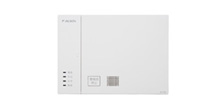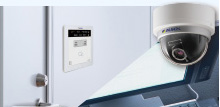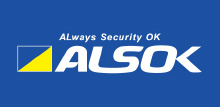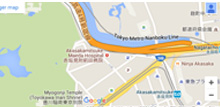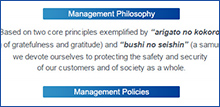Corporate Governance
The ALSOK Group includes "Based on two core principles exemplified by ‘arigato no kokoro’ (a feeling of gratefulness and gratitude) and ‘bushi no seishin’ (a samurai spirit), we devote ourselves to protecting the safety and security of our customers and of society as whole." in its management philosophy and includes "Contributing to Society" in its management policies. In line with this philosophy and policy, we are working to fulfill corporate governance through our operations such as, performance of management and seperation of supervisory, swift decision making, establishment of corporate ethics, and securement of management transparency, while endeavoring to remain the corporate group reliable to all stakeholders. Moreover, we place emphasis on information disclosure. We work positively on IR activity such as the execution of visiting every institutional investor and holding analyst meetings for investors and analysts. The ALSOK Group inspects and reviews such as organization structure, by observing the principles in "Corporate Governance Code" laid down by Tokyo Stock Exchange. We submit "Corporate Governance Report" to Tokyo Stock Exchange every year and post to both Tokyo Stock Exchange and ALSOK website. The ALSOK Group aims at the construction of the organizational structure to which the corporate governance functions more effectively, and will continue the examination of the measure for various systems.
An outline of the Corporate Governance System Reason to Adopt ItOpen
The Company is a company with the Audit & Supervisory Board. It is effectively and with fulfillment audited by Audit & Supervisory Board members and the governance towards the management is effectively functioned.
As of June 25, 2025, the Company consists of 11 directors (including 5 outside directors) and 4 Audit & Supervisory Board members (including 3 outside Audit & Supervisory Board members). The Board of Directors is held once a month as to determine important matters concerning basic policy of management and business execution, and to supervise execution of duties by directors and executive officers. Furthermore, executive committee chaired by the Representative Director Group CEO is held twice a month with determining the issues to be discussed at the Board of Directors, and concertation of business execution policy based on the determination at the Board of Directors. The Audit & Supervisory Board is held once a month, as to discuss or resolve important matters concerning the audit. Also, one Audit & Supervisory Board member is to attend the executive committee, and monitor the affairs of executive management adequately.
On February 7, 2023, the Company established the Nomination and Remuneration Committee as an optional advisory body, with independent outside directors comprising the majority of members, to ensure objectivity and transparency in the method of determining the nomination and remuneration of directors (excluding outside director), and to further enhance the corporate governance system.
Moreover, the Company and outside directors/ outside Audit & Supervisory Board members have concluded a contract to limit liability for damage stipulated in paragraph 1, Article 423 of Companies Act in accordance with paragraph 1, Article 427 of Companies Act. The amount of limit of liability for damage is stipulated in the relevant contract as 10 million yen or the minimum amount of limit of liability that paragraph 1, Article 425 of Companies Act stipulate, whichever is higher. These are for the aim of outside directors and outside Audit & Supervisory Board members to fully play a role expected.
Reasons for Appointment and Duties of Outside Directors and Outside Audit & Supervisory Board MembersOpen
Outside directors attend the Company’s Board of Directors with outside Audit & Supervisory Board members and remark appropriately. Moreover, outside director monitors effective management as to receive in advance an overview of matters to be discussed in the Board of Directors from General Manager of General Affairs Department. Besides, outside Audit & Supervisory Board members cooperate mutually with supervision by outside director, audit of Audit & Supervisory Board members, internal audit and financial audit with regularly exchanging information and opinion with Audit & Supervisory Board members and audit corporation as well as other Audit & Supervisory Board members.
The relationship between these supervision or audit and internal control section are as follows.
The relationship between these supervision or audit and internal control section are as follows. Outside directors, supervise business execution of other directors within internal control section from an independent position through the participation of Board of Directors. Outside Audit & Supervisory Board members evaluate the legality of operations in internal control section and consult of various materials as well as other Audit & Supervisory Board members.
The system is adopted with the judgement of impartiality for management and appropriate transparency.
Compensation for Directors and Audit & Supervisory Board MembersOpen
Amount of compensation
Number of members and total compensation for each classification in the fiscal year ended March 31, 2025 are as follows.
| Directors (Excluding outside directors) |
7 members | ¥294 million |
|---|---|---|
| Audit & Supervisory Board Members (Excluding outside audit & supervisory board members) |
1 members | ¥23 million |
| Outside directors and audit & supervisory board members | 10 members | ¥88 million |
Contents of the policy regarding the amount of remuneration for officers
With the resolution of General Meeting of Shareholders, the Company decides the maximum remuneration paid to directors should be 600 million yen in total (the number of directors involved in the resolution is 12; June 25, 2024) and as for Audit & Supervisory Board members shall be 120 million yen in total (the number of Audit & Supervisory Board members involved in the resolution is 4; June 30, 1998).
The remuneration paid to directors, based on the following policies decided by the resolution of the Board of Directors, consists with the flat amount determined by the appointment and outside director, other directors besides, and with the productivity-linked remuneration calculated by the performance feedback of each directors by certain standard.
The basic policy and method of determining the remuneration of the Company's directors (excluding outside directors) are determined by the Board of Directors after deliberation and reporting by the Nomination and Remuneration Committee, an optional committee with independent outside directors comprising the majority of members.
The remuneration paid to Audit & Supervisory Board members is flat amount and the specific amount is determined following the standard decided at Board of Directors.
Policy on determining the payment ratio of productivity-linked remuneration and non-productivity-linked remuneration
Regarding the remuneration of the directors (excluding outside directors), the fixed compensation notified in advance (so-called bonus) paid in June every year corresponds to the productivity-linked remuneration.
If the company performance payment rate and the individual performance payment rate are both 100%, the payment ratio will be 45% of the total annual remuneration (short-term incentive: 30%, medium- to long-term incentive: 15%). In addition, the monthly remuneration corresponds to remuneration other than productivity-linked remuneration, and the payment ratio is 55% of the total annual remuneration when both the company performance payment rate and the individual performance payment rate are 100%.
Policy for each position regarding the determination of the amount of remuneration for officers or the calculation method thereof
Of the remuneration of the Company's directors (excluding outside directors), the monthly remuneration is paid by adding the "role allowance" and "director's allowance" to the basic salary and the amount of payment is set for each rank.In addition, the standard amount of fixed compensation notified in advance is set in conjunction with the monthly remuneration.
Index related to the productivity-linked remuneration, the reason for selecting the index, and the method of determining the amount of the productivity-linked remuneration
When calculating the fixed compensation notified in advance, which is a productivity-linked remuneration, as for short-term incentives, the company performance payment rate is calculated from the standard index (consolidated operating profit + equity method investment profit + consolidated bonus) processed from consolidated operating income, and as for medium- to long-term incentives, the company performance payment rate is calculated based on the three-year compound annual growth rate of the standard index. In addition, the individual performance payment rate is determined by the degree of achievement of the goals set for each individual. After that, the amount of payment for each individual is finally decided by multiplying the standard amount by each payment rate according to the following formula.
[Formula for calculating the average annual growth rate of the standard index]
Compound annual growth rate = {(standard index ÷ standard index 3 terms ago) to the 1/3 power} -1
[Formula for calculating short-term and medium- to long-term incentives]
Individual payment amount = Standard amount × Company performance payment rate × Individual performance payment rate
The reasons for adopting the above standard index are as follows.
(A) Improving the performance of the entire group, including equity method affiliates is the main role of officers.
(B) Consolidated operating income excluding the effects of fluctuations in bonus payments is considered to be a better indicator of company performance.
The name or name of the person who has the authority to determine the amount of remuneration, etc. for officers or the policy for determining the calculation method, the content of that authority, and the scope of discretion
The basic policy and method of determining the remuneration of the Company's directors (excluding outside directors) are determined by the Board of Directors after deliberation and reporting by the Nomination and Remuneration Committee, an optional committee with independent outside directors comprising the majority of members.
When determining the amount of productivity-linked remuneration to be paid to directors in the relevant fiscal year, the Board of Directors of the Company is considered to be in a position to most appropriately evaluate each director individually in terms of the individual performance payment rate. Therefore, we delegated to Tsuyoshi Murai, Representative Director and Group CEO, and Ikuji Kayaki, Representative Director and Group COO, to determine the payment rate based on the achievements of each director's challenges and achievement targets (KPI) for the relevant fiscal year.
The Board of Directors of the Company has determined that the individual remuneration of directors is determined by the above method, and that the content is in line with the decision policy.
Activities of the Board of Directors in the process of determining the amount of remuneration for officers in the most recent fiscal year
Remuneration for directors of the Company is a matter to be resolved by the Board of Directors in accordance with the rules of the Board of Directors. We have been deliberating on the remuneration system, revision of calculation method for the fixed compensation notified in advance, and performance payment rate and individual performance payment rate for the fixed compensation notified in advance.
In the current fiscal year, the Board of Directors meeting held on May 14, 2024 discussed the company performance payment rate and individual performance payment rate regarding the fixed compensation notified in advance scheduled to be paid in June of the same year.
The productivity-linked remuneration for the current fiscal year was 69,299 million yen (achievement rate 100.5%) compared to the planned amount of 68,966 million yen.
Matters Related to the Internal Control SystemOpen
Based on Corporation Law and Financial Instruments and Exchange Law, the Group is maintaining system to secure the rightness of business for other corporations, corporate group which are made up from such company and subsidiaries and agreement for execution of duty as director and employee to law and certificate of incorporation.
System to secure the agreement of execution of duty as directors and employees to law and certificate of incorporation.
- Ever since the company was founded, we have cherished "the ALSOK Charter", which is composed of the founder's spirit and motto of the company. We have encouraged our business activity in accordance with the charter.
- We watch the execution of function, by establishing “Board Regulations”, “Internal Memo Regulations”, “Policies of Dividing Duties”, and “Policies of Administrative Authority”, divide administrative authority, and obligate final decision that exceeds authority in charge.
- We enacted an “Ethical Rule” as standard for the action based on the ethics with sincere performance of duty.
- We adopted “Compliance Rule” and made one of the directors as the director in charge of compliance, who reports activity conditions to Management Committee and the Board of Directors Meeting if necessary.
- We established “Internal Report Rule” in order that we can construct the internal report system and operate it appropriately.
- We established the internal audit exclusive jurisdiction department under the direct control of the President. The department regularly inspects management activities at all departments in the headquarters and branches and reports the results to the auditors and directors.
- Based on the law of Financial Instruments and Exchange Act, we maintain and operate systems to make the financial reporting properly is maintained and operated.
- We adequately conduct various education such as law, articles of incorporation, and internal rules for directors and employees.
System concerning preservation and management of information that lies execution of duty as director
- Establish an order concerning primary information that show the execution condition of General Meeting of Shareholders record, Board of Directors record, Management Committee record, request for approval, contracts, account book, financial documents, and other services as to conservation management concerned information.
- Allow directors and Audit & Supervisory Board members to browse these information anytime.
Other systems of regulations concerning management of to risk of loss
- Together with establishing “Risk Management Rule” and naming the risk management officer, we estimated and evaluated risks. Person in charge should report to the Board of Directors Meeting and Management Committee as needed and to come out with needed measures of prevention, reduction, transfer of risks or settle coping strategy when risk occurs.
- . We establish “Business Continuity Plan”, adjust the systems, and measures when natural disaster occurs.
- Together with establishing “Information Asset Management Rule” and naming the information asset management officer, we formulate the structure to protect the information asset from threats such as robbery, divulgation, falsification, depredation and disasters
System to secure efficient execution of director's duty.
- The management plan of the mid-term and fiscal year is made based on the business objective.
- As for the management plan of fiscal year, it is reported to the Director and the Management Committee every month, and the progress management is carried out monthly.
- "Administrative Authority Regulation" is enacted, and an efficient decision making is done by allotting the administrative authority.
- The business processing is simplified by the backbone system that uses IT, and is planned to make the management and business more efficient and rationalize.
System to secure propriety of business in corporate group that consists of our company and subsidiaries.
- The rule for the business management of the subsidiaries is enacted together with the exclusive competency post set up, and the umbrella administration is carried out. For subsidiaries, besides making report concerning exercise of function, strict guide and supervising toward the subsidiaries is done, by sending the director or the Audit & Supervisory Board member from our company.
- Significant information concerning the risk of loss for subsidiaries should be reported to subsidiaries competency post based on the rule for the business management, risk correspondence is carried out in cooperation with the group.
- The subsidiaries shares information with our company through various conferences and in-house electronic bulletin boards, and improve operational efficiency through application of operation system common in subsidiaries. Designing the group`s medium-term management plan and annual management plan, progress management of the plans are carried out the monthly business condition reported from subsidiaries.
- Our company and the subsidiaries operate the execution of the compliance activity and the internal report system and completely intercept the relation to antisocial forces, and for such occasions, approaches for necessary maintenance of the company structure and cooperation with external specialized agencies are carried out. In cooperation with subsidiaries, internal audit is carried out for significant subsidiaries.
System that secures the effective audit by the Audit & Supervisory Board Members
- The audit & supervisory board secretariat is established, and the employee who assists the duty as the audit & supervisory board member is arranged.
- The audit & supervisory board secretariat member's personnel affairs are to acquire the agreement of the Audit & Supervisory Board. The audit & supervisory board secretariat members solely comply with command from audit & supervisory board members.
- The director and employees report to the audit & supervisory board members about an important matter concerning business.The audit & supervisory board members attend the Board of Directors' Meeting and the Management Committee.The internal audit exclusive competency post performs information exchange regularly together with the audit & supervisory board members.
- Appropriate report is carried out promptly by the directors and employees of the subsidiaries, when the report concerning is desired. Department in charge of internal report, reports significant notify including the notify of subsidiaries to the audit & supervisory board members. Furthermore, for our directors, employees and directors of subsidiaries who reported to audit & supervisory board members are not to be unfavorably-treated for the reason to have been reported.
- Our company annualy set a certain amount of budget to pay expenditures which come about from the excercise of function of audit & supervisory board members. When the audit & supervisory board members charge for such expenditures, it is handled properly.
- The audit & supervisory board members regularly exchange opinions or interview with the President and each general manager, and audit each office and subsidiary. The audit & supervisory board members regularly hold the skull sessions with Audit Corporation.
Condition of Maintenance for the System of Risk ManagementOpen
Our company is especially attaching importance to risk management on the character to assume securing of a safe society to be a company's business. The Risk Management Committee is organized based on the current Risk Management Regulation enacted in 2002, and the risk management director is assumed to be the chairman. Moreover, the risk management examination organization is enacted in the head office and each office, and it is working on the risk management such as identifying the risk, evaluation, the precaution, and the measures idea as all companies are covering.In addition, the risk examination departmental meeting according to the field put in the Risk Management Committee, risk information on each pertinent field is collected, analyzed, evaluated, and the measure for the risk reduction is examined. To attempt the rapid deployment, the organizational structure is maintained much more in an urgent reporting system when the matter of great importance idea is generated and the installation of the task force.
Regarding compliance, the Compliance Committee that makes the compliance director as chairman is organized and is attempting on compliance. The Compliance Committee works for knowing the compliance consideration toward the director and the employee based on the current Compliance Regulation enacted in 2002, and is regularly checking the business activity condition. For earlier detection and the prevention of the problem in corporate ethics, "ALSOK Hotline" was installed in 2004, and when encountering a malfeasance, misbehavior, and an anti-ethical act that the employees and officers lies a company, the system that can internally be informed is constructed without receiving a prejudicial treatment. Moreover, as a window of reports, besides the existing internal window, external window has been established in 2016. In addition, from December 2021, the "ALSOK Business Partner Hotline", the contact point for reporting business partners, has been established, which aims to ensure self-cleaning, social trust, maintenance and improvement of corporate value, and sustainable development with business partners.
Additionally, the Group set "Basic policy for information security" as cornerstone of ensurement of information security, and apply to all employees including board members and all information assets. Based on information assets management regulation, construction and promotion of information assets management system and trainings concerning serious accidents are conducted. Furthermore, when serious accident occurs, the Group lay out the framework of corresponding to the accident and prevention of recurrence, and establish ALSOK-CSIRT(Computer Security Incident Response Team).
As for the lawsuit, the dispute, and other legal risk, the legal affairs room is enacted and it corresponds while cooperating with each operations division. Moreover, our company is straightening the system to prevent the risk beforehand as adviser contracts with seven law firms are concluded, and advice and guidance such as events concerning an important legal problem and compliance are received properly. The lawyer is made to take part in the corporate governance through the maintenance of compliance looking up at such advice and guidance.
In response to the occurrence of cash-related scandals, the Company has taken measures such as further tightening cash management, strengthening guidance and education for employees, and thorough personnel management to reinforce legal compliance. increase. In February 2022, two subsidiaries of the Company received a cease and desist order and a surcharge payment order based on the results of an investigation by the Japan Fair Trade Commission regarding antitrust violations. Immediately after the on-site inspection of the Fair Trade Commission, the Group strengthened the legal consultation system by establishing a specialized department, strengthened in-house training, established a legal compliance manual on fair trade, re-disclosed the whistleblowing system, strengthened audits, etc. We are implementing measures to ensure thorough legal compliance.



